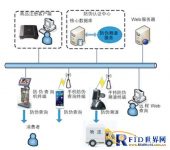
RFID technology-based alcohol anti-counterfeiting traceability and anti-crossing goods system
[ad_1]
1. Background-current problems in the production of wineries
In today’s society, counterfeit goods have become a worldwide problem. Driven by interests, counterfeit and inferior products are increasingly rampant in the market. Especially for alcoholic products, it has become one of the key points of counterfeit and inferior manufacturing by criminals, giving people’s lives and lives. Security has brought great threats and also caused huge losses to enterprises. The fake liquor case in Shuozhou, Shanxi that shocked the country in 1998 caused 27 deaths and more than 200 people were hospitalized, causing immeasurable losses to the liquor industry in Shanxi Province and the national liquor industry. At present, the difficulty of imitation of alcohol anti-counterfeiting technology is not high. Commonly used alcohol anti-counterfeiting technologies include physical destruction, fragile labels, laser anti-counterfeiting, and code telephone inquiries. Counterfeiters often master the anti-counterfeiting technology quickly, and even counterfeit it with technology developers who lack self-discipline, causing headaches for alcohol production companies. It is urgent to establish a platform for anti-counterfeiting and traceability of alcoholic beverages and anti-crossing goods.
The management information system for quality traceability, anti-counterfeiting, and anti-crossing of goods for wine enterprises, through the unique identification of the product in the production process, records and traces the information of the production, circulation, and sales of each product, so that the quality problem products can be accurately determined. Traceability, and from the perspective of corporate market management, can realize product anti-counterfeiting and anti-squatting, avoid business losses, and can also enhance the product’s good image in the market. On this basis, the management efficiency of enterprise product warehousing logistics can also be improved.
2. The advantages that RFID brings to wine anti-counterfeiting traceability and anti-crossing goods
2.1 The emerging of RFID technology
Radio frequency identification technology (RFID) can realize the tracking and information sharing of items on a global scale through the combination of Internet technology. It is the direction of future enterprise informatization development. The alcohol anti-counterfeiting system and method based on RFID technology, using large-scale integrated circuit manufacturing, has the characteristics of high processing difficulty, low cost, and the ability to authenticate product information by enterprises, which will bring revolutionary breakthroughs in alcohol anti-counterfeiting technology.
2.2 Problems that need to be solved in RFID anti-counterfeiting traceability and anti-crossing goods
At present, the following five problems need to be solved in the application of RFID alcohol:
1. The RFID anti-counterfeiting label must be completely destroyed after the product is used and cannot be used again;
2. RFID anti-counterfeiting labels must be unique and cannot be copied during use;
3. Provide consumers with simple and easy means of counterfeiting;
4. Meet the needs of traceability management.
5. Satisfy the needs of wine enterprises for management of various markets.
2.3 The effect of RFID wine anti-counterfeiting traceability and anti-crossing goods
The use of RFID non-contact radio frequency identification technology applied to alcohol anti-counterfeiting technology has effectively prevented criminals from fraud. Based on RFID technology, a complete anti-counterfeit traceability and anti-crossing goods management system is formed from the production, inventory, logistics, sales, and finally to consumers’ drinking by wine manufacturers. Each link of production, circulation, and sales is optimized, and the entire link is meticulous to realize scientific information management. It can effectively prevent counterfeiting, effectively transmit information, improve the monitoring of all links, can effectively ensure the quality of wine and the interests of manufacturers and merchants, prevent counterfeit products from flowing into the sales market, control product quality, supervise and manage sales personnel, formulate reasonable service strategies, Prevent diversification of goods, strengthen the control and management of each market, guide the product design positioning of enterprises, and improve the timeliness of business decision-making, thereby perfecting the entire industrial chain of the wine market.
Three, system introduction
Assign a uniqueRFIDFor logistics labels, an RFID reader (or RFID handset) is deployed in each monitoring link. The RFID reader will automatically identify and upload the RFID logistics label data entering the area to the back-end database, and any clues will leave accurate Log, for illegally moving alcohol packaging boxes, you can immediately initiate a warning message to the staff on duty. Sampling inspection or inventory personnel take RFID handhelds to the site for inspection or inventory, using the technical advantages of RFID remote identification, combined with WIFI/3G/4G mobile Internet, and the data is transmitted to the back-end database in real time. Consumers or regulatory authorities can use their mobile phones or self-service inquiry machines to trace the source of food at any time.
3.1 System framework

Figure 1. Anti-counterfeiting traceability system framework
3.2 System function
1. Provide each product attribute information and production, warehousing, logistics information, etc., to the upper application system, including label verification result information, single product logistics information, box logistics information, system error statistical information, etc.
2. Realize real-time online upload of product information, production and other business operations, and local backup and storage of important data.
3. The generation and maintenance of logistics information, and the association with the label; the processing of single product logistics information, box information,
4. Complete system management and configuration functions.
Four, product life cycle process traceability process

Introduction to product life cycle process traceability
1. Paste radio frequency electronic tags
2. Install a fixed read-write device on the production line, write data into the tag, and automatically record the information
3. Distribution logistics management
4. Distributors and retailers are equipped with hand-held phones to check the authenticity of wine, and retailers use hand-held phones to check the authenticity of the products on the spot when consumers buy products.
[ad_2]



